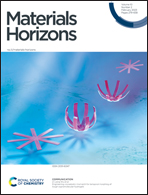Capacitive–piezoresistive hybrid flexible pressure sensor based on conductive micropillar arrays with high sensitivity over a wide dynamic range†
Abstract
Flexible pressure sensors are the foundation of wearable/implantable biosensing and human–machine interfaces, and mainly comprise piezoresistive-, capacitive-, piezoelectric-, and triboelectric-type sensors. As each type of sensor exhibits different electro-mechanical behaviors, it is challenging to detect various physiological mechanical signals that cover a large pressure range using a given sensor configuration, or even a single type of sensor. Here, we report a capacitive–piezoresistive hybrid flexible pressure sensor based on face-to-face-mounted conductive micropillar arrays as a solution to this challenge. The sensor exhibited high sensitivity over a wide dynamic range of five orders of magnitude, which covers almost the full range of physiological mechanical signals. A process for fabricating large-scale and morphologically homogeneous conductive micropillar arrays was first developed and refined. This track-etched-membrane-based process provides a facile, cost-effective, and highly flexible way to precisely adjust the morphology, modulus, and conductivity of the micropillars according to the application requirements. Subsequently, conductive-micropillar-array-based pressure sensors (MAPS) were developed and optimized to attain all-round sensing performance. The pillar contact behaviors generated significant variations in both the capacitance and resistance of the MAPS in the low-pressure regime (10−4–0.2 kPa), providing high sensitivity in both the capacitive and piezoresistive working modes. The vertical contact, bending and thickening of the pillars under medium pressure (0.2–16 kPa) led to a continuous linear response in both modes. Configuration and optimization enabled the MAPS to detect acoustic pressure (<1 Pa), milligram weights, soft touch (<1 kPa), arterial pulses (1–16 kPa preload), joint motions and plantar pressure (∼100 kPa), and the hybrid sensing mode allowed the MAPS to work in a desirable way. In this work, the piezoresistive mode was mainly employed for a higher accuracy and sampling rate, and can apparently simplify IC design for wearable applications. The circuit converts the resistive variations into electrical signals via the voltage division method and directly reads out the signals after further amplification, filtering and transmission. The improved facile and highly adjustable fabrication process, as well as the flexible hybrid sensing strategy, will benefit the unified design, batch production, quantifiable optimization, and functional diversity of wearable/implantable bioelectronics.



 Please wait while we load your content...
Please wait while we load your content...